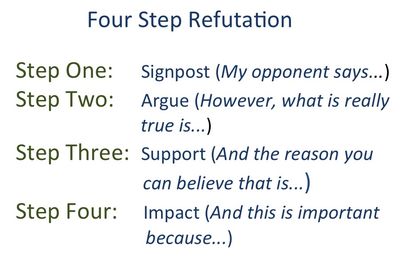By Dr. Ken Broda Bahm:
Though Denver is still encased in snow, youth soccer season is just around the corner, and soon I’ll be watching my daughter and her teammates chase the ball around the field. At this age (six), they’re not yet playing positions, so one common bit of advice from their coach is this: “When you have the ball, take it to the goal! Don’t dribble it around and don’t play ‘keep away’ with the other team. Instead, take it to the goal every time.” I was reminded of that advice recently while watching mock trial presentations from a closed-circuit room. “That is why the point where valuations apply has to be after and not before the deductions and discounts,” the presenting attorney concluded. The attorney’s face held the triumphant look of one who had just put the final point on a long and undeniable argument. But watching all the mock jurors on split screen, I saw a wall of blank faces, as if one collective “So what?” was rising up from the group.
This can be a common occurrence and it reflects a common liability for the legal advocate. The important gap between you and your fact finders is not a gap in intelligence, nor even a gap in the ability to understand each point as it comes along. Instead, the important gap is one of perceived relevance: The knowledgeable and experienced advocate is so much more likely to see the “why this matters” part of the argument that they’re too frequently tempted to just leave it out. That is why the reminder for pint-sized soccer stars is also a good reminder for trial lawyers: Take it all the way to the goal, every chance you get. Legal advocates should make their argument clear and explicit, not simply through the most controversial points, but all the way to the part that conveys “…so that is why we win.” This advice applies not only to jury persuasion, but also — and perhaps especially — to the more involved claims presented to the bench, either orally or through briefs. It’s easy advice to understand, but also easy advice to forget. So in this post, I’ll be sharing three practical tools lawyers can use to make sure they’re making complete arguments and taking it to the goal every time.
Before You Finish a Point, Ask, “Have I Taken It to the Goal?”
Effective advocates should embrace a style that makes no assumptions, makes every step explicit, and ends with the ultimate conclusions: “The contract is/isn’t breached,” “The patent is/isn’t infringed,” or “Professional malpractice has/hasn’t been committed.” In your own perception, you likely believe you’re already doing this, and you probably are in many to most cases. However, becoming a specialized attorney means developing a large number of mental short-cuts that allow complex ideas to be processed and discussed in short order. Those habits can be hard to set aside even with conscious effort. And the continuing confusion of many mock jurors and judges speaks to the reality that litigators should be even more consistent and even more thorough in laying out each step and, in particular, even more conscious of ending with the conclusion that brings the audience all the way back to the ultimate claim.
Drawing from my days as an argumentation professor, I want to share three related questions, each with a corresponding checklist for advocates.
Have You Made a Complete Argument?
What is a complete argument? The standard reference on that point, courtesy of British logician Stephen Toulmin, is that a complete argument is one that contains three basic elements:

For example, the claim might be “There’s a fire,” the data is “I smell smoke,” and the warrant — you guessed it — is that “Where there’s smoke, there’s fire.” In ordinary conversation, it is common to leave one or more of those parts out, thinking the claim is understood, the data is familiar, or the warrant is just basic logic. But when dealing with arguments in a challenging setting like the law, it can help to be explicit on each step.
As a simple illustration, think about a products defendant making the claim that the product is generally safe. They support that with data showing very few incidents of injury, but leave out the warrant thinking that it (‘the fact of few incidents is a sign of a safe product’) is obvious. The juror, though, holds to a view that: “Safe means safe, and any incidents are too many.” That juror may supply a warrant that is opposite of what’s intended (“The presence of these incidents is a sign of an unsafe product”). Making the preferred warrant explicit is no guarantee, since the target can still reject it. But by adding in backing for that warrant (e.g., “As long as there are user errors and freak accidents, injuries can never be zero”), advocates improve their chances for both clarity and persuasion. So this simple mnemonic — claim, data, and warrant — offers a ready checklist for the attorney wondering, “Am I being clear enough?”
Have You Carried That Argument All the Way to the Finish Line?
What is the conclusion? Or more specifically, how do you know when you’ve made it all the way to an ending point? In a narrative, that ending point usually comes in some kind of closure — a sense of ‘coming home.’ Sometimes that sense of coming home is literal (think, The Odyssey or The Lord of the Rings). At other times, it is a more general feeling that ‘Now, things are complete.’ In an argument, that completeness is the end state you want your target to reach.
Here is a useful tool for knowing when you’re there. As you complete each point, picture an imaginary audience asking two questions:
 So, you fill in more information and your imaginary audience asks those same two questions again. The point at which these questions become stupid or obtuse is the point where you can say you’ve brought the argument home.
So, you fill in more information and your imaginary audience asks those same two questions again. The point at which these questions become stupid or obtuse is the point where you can say you’ve brought the argument home.
Have You Beaten the Other Side?
You may have had the experience of watching the mock jurors or judges accepting an opponent’s argument and thinking, “Wait, I responded to that argument… and they said nothing about my response.” What I’ll often reply in those situations is, “Okay, you responded but, did they know that you were responding?” In other words, did the fact finders recognize what you said as refutation, or did they simply see it as more argument? When you are pulling down one of your adversary’s contentions, it is important for your target audience to know what you’re doing.
Thankfully there is one tool, widely taught to students of argumentation and debate, for accomplishing precisely that. We have written about it before in the context of rebuttal arguments, but it applies anytime you are responding to or preempting what the other side is saying. It is even a good model for testimony that aims to counter your opponent’s testimony.
It goes like this:
Following these steps creates a natural way of making sure that the relevance of the point is clear. For example, a defendant in a professional malpractice trial might testify as follows: The plaintiffs’ expert has testified that standard of care requires diagnosis of the disorder before the patient is six months old. (Step one). But it cannot. (Step two). The reason for that is that in five percent of cases, symptoms do not manifest until after six months. (Step three). And if the standard cannot require diagnosis by six months in each case, then we cannot rely on that alone. We have to look at other aspects of care. And when we do that, we see no breach in standard of care. (Step four).
Attorneys should use these and other tools to address the comprehension gap. For the best clarity, continuously emphasize relevance and draw the connections between the points you’re on and the ultimate conclusion. Carry the point all the way to the goal.
______
Other Posts on Argument:
- Don’t Let Your Judge Reduce You to Absurdity
- Avoid the “And Another Thing…” Style in Rebuttal
- Don’t Chase Every Rabbit: The Art of Issue Selection
______
Photo Credit: Bods, Flickr Creative Commons

